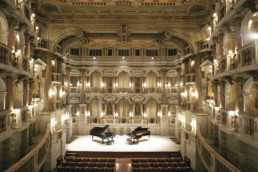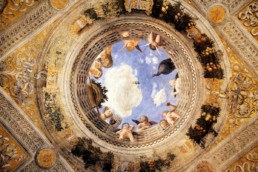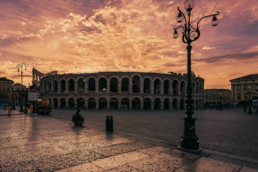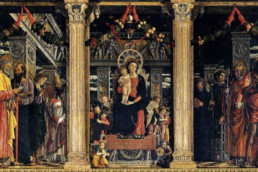Wednesday, 17 May 2017
4.00 – 7.00 pm
Registration
Mantua: Madonna della Vittoria, Via Claudio Monteverdi, 1. {Open in GOOGLE MAPS}
Verona: Hotel Due Torri, piazza Santa Anastasia {Open in GOOGLE MAPS}
5.00 – 7.00 pm
Mantua: Palazzo d’Arco, Piazza d’Arco 2. {Open in GOOGLE MAPS}
Executive Commitee Meeting
The house of the Counts of D’Arco, as appears in its current neoclassical form, was built after 1784 by commission from Gherardo D’Arco. The project was tasked to neoclassical architects Antonio Colonna and Paolo Pozzo. In the 1870s Countess Giovanna, the last heir of the noble house, bequeathed the building to the City of Mantua.
The palace looks as though it was still inhabited. The painting gallery has a remarkable collection, with works of art from the XV to the XVIII century, from Niccolo’ da Verona to Rubens, Van Dick, Luini, Sodoma, Bazzani, and Magnasco. The XIX century kitchen with its copper ware collection is quite interesting. Besides the semi-circular portion of the parade ground, the palace also features a romantic garden, the XVI century buildings that house Antonio d’Arco’s natural science collection and the Giovanni Maria Falconetto’s early XVI century grand fresco cycle at Sala dello Zodiaco.
Thursday, 18 May 2017
8.30 am
Transfer to Sabbioneta
9.30 – 11.30 am
Sabbioneta, Teatro di Vincenzo Scamozzi {Open in GOOGLE MAPS}
World Federation Council Meeting
The theatre was designed in 1588 by architect Vincenzo Scamozzi for Vespasiano Gonzaga Colonna, Duke of Sabbioneta. The innovative entrance system, the mixed profile of the cavea, and the changing rooms for actors and orchestra players at the back of the stage, puts it among the most prominent examples among European theatres. The elegant decorative structure of the main hall is suspended between a re-visitation of Vespasiano’s favourite classical myths and the current taste of the painted balustrade on the upper tier of the room, displaying musicians, comedians, dames and knights in late XV century attire.
Coffee break
11.30 am – 1.00 pm
Sabbioneta, a cultural sightseeing tour of the UNESCO heritage city
Sabbioneta was founded by will of Vespasiano Gonzaga Colonna (ab urbe condita, 1556 – 1591), a condottiere, enlightened and cultivated prince and a scholar of Vitruvius. It was the capital city of the tiny Gonzaga duchy: well protected by the ramparts of the strong, star-shaped walls whose project is attributed to Vespasiano himself, Sabbioneta was also a modern hub for art and culture, a sort of “small Athens”. The walls still guard the checkerboard urban structure as well as the sophisticated XVI century buildings. Among the most interesting parts, the gateways called Imperiale and della Vittoria, the Galleria degli Antichi, the Theatre, the Palazzo Ducale – the first major building ever built in Vespasiano’s new city – and the archpriest church of Santa Maria Assunta. Other noteworthy landmarks are the “Casino” or Palazzo Giardino, the duke’s otium sanctuary, the Colonna della dea Pallade, a statue of Adrian or Anton age purchased on the antiquity market by Vespasiano; the church of Incoronata, a Ducal mausoleum where in the summer of 1988 the restoration works unveiled the tomb of Vespasiano Gonzaga.
1.00 – 2.00 pm
Cantine di Palazzo Ducale {Open in GOOGLE MAPS}
Buffet lunch with the Companions
2.15 pm
Transfer to Mantua
3.00 – 4.30 pm
Mantua, Palazzo Te – site tour with the Companions’ group {Open in GOOGLE MAPS}
Palazzo Te is considered the masterpiece of Giulio Pippi de’Jannuzzi, also know as Giulio Romano. The main architecture and the palace’s decorative structure were inspired by the Roman domus, and were entirely made between 1525 and 1535 in an area right outside of the city and commissioned for the “leisurely time” of Federico II Gonzaga. In spite of the several restoration projects over the centuries, Palazzo Te is one of the most outstanding and better-preserved Renaissance buildings of Europe. There, Giulio collected his profound knowledge of classical culture and his flawless mastery of the contemporary greats, from Raphael to Michelangelo, not to mention his ingenious, ground-breaking inventions that still impress visitors.
4.30 – 6.30 pm
Return transfer to the hotels, free time
6.30 pm
Transfer to Mantua
7.30 – 8.45 pm
Mantua, Palazzo Ducale, Giardino dei Semplici {Open in GOOGLE MAPS}
Garden of Simples (herb garden) in The Ducal Palace was wanted by Vincenzo I Gonzaga, fourth Duke of Mantua. Recently the Garden has been redesigned according to the plan and plants chosen in 1603 by the naturalist and botanist Zanobi Bocchi. The Garden has an “esoteric” dimension, intimate and sacred at the same time. The square form, divided in four parts, recalls the four corners of the world, and also the four Elements, the four seasons, the four Humours, the phases of the Alchemical Teaching which aimed to achieve the immortality Elixir. In the center, on the intersection of the diagonal lines, is located a water tank from which, allegorically, were flowing the four rivers of Eden.
Welcome drink
8.45 pm
Mantua, Teatrino Scientifico dell’Accademia {Open in GOOGLE MAPS}
Concert in honour of the World Federation of Friends of Museums
Teatro dell’Accademia was commissioned by Mantua academics to architect and stage designer Antonio Galli Bibiena in 1767 to hold scientific exhibitions, cultural conferences and musical performances. The superb Baroque architect conceived a stunning theatre hall in the shape of a bell, with 3 tiers of boxes, which he personally decorated with monochrome frescoes. Thanks to the perfect acoustics, this theatre is one of the most coveted venues among chamber musicians for their performances and recording sessions.
A few months after the opening, a thirteen-year old Wolfgang Amadeus Mozart performed in this venue. His father Leopold wrote his wife that he had seen “the most beautiful theatre in the world”.
Società della Musica ‘GRANDI INTERPRETI’, Francis Duroy, violin Agnès Melchior, piano
Saint-Saëns:Danse Macabre
Debussy’s: Sonata for Violin and Piano
Bartok: Rhapsody No. 1 for violin and piano
Ysaÿe: sonata for solo violin No. 3
Schumann: Sonata for Violin and Piano No. 1
Return transfer to the hotels
Teatrino Scientifico dell’Accademia (Teatro Bibiena), Mantova
Friday, 19 May 2017
8.45 am
Transfer to Mantua
Mantua, Teatrino Scientifico dell’Accademia
9.30 am – 1.00 pm
Congress opening, institutional addresses {Open in GOOGLE MAPS}
Coffee break
Working session:
Table 1 – discussion subject: ‘Communication and the Media for the benefit of cultural heritage’
1.00 pm
Lunch at “Piermarini” hall – Palazzo dell’Accademia
Palazzo dell’Accademia is a building designed by Giuseppe Piermarini as the seat of the “Royal Academy of Science, Literature and Art”, under the tutelage of Empress Maria Theresa of Austria. Over time the institution came to be known as the “Accademia Nazionale Virgiliana”. The upper floor houses the beautiful Accademici meeting room, also known as Piermarini room, designed in 1775 by architect Paolo Pozzo. The plasticity of the ornaments, made by Stanislao Somazzi on a design by Giuseppe Bottani, is particularly exquisite. Three large canvases by Hubert Maurer celebrate the Imperial Family.
2.30 – 4.00 pm
Teatrino Scientifico dell’Accademia
Afternoon session
Table 2 – discussion subject – ‘Cultural heritage laws and taxation’
5.00 pm
Mantua, Palazzo Ducale {Open in GOOGLE MAPS}
 Sightseeing tour for Delegates and Companions
Sightseeing tour for Delegates and Companions
Mantua’s Palazzo Ducale, between piazza Sordello and Lungolago dei Gonzaga, is one of the most articulate, layered and, in spite of having been dramatically plundered at times, extraordinary examples of western hemisphere art and history.
The connections among its various elements – streets, squares, courts, gardens, bridges, overpasses and underpasses commissioned in the mid XVI century by Duke Guglielmo – make this monumental complex a city within the city, and the sumptuous and celebrated seat of the prestigious Signoria for centuries; a place always abreast of art avant-gardes, so much that many of its corners can be considered true manifestos of European cultural art between the XV and the XVII century.
At the end of the tour, farewell cocktail at Cortile d’Onore
Return transfer to the hotels
The Camera degli Sposi, sometimes known as the Camera picta, is a room frescoed with illusionistic paintings by Andrea Mantegna in the Ducal Palace, Mantova
Saturday, 20 May 2017
9.00 am -1.00 pm
Verona, Sala Maffeiana {Open in GOOGLE MAPS}
Sala Maffeiana is part of the original layout of Teatro Filarmonico dating back to the middle of the XVIII century. The main opera house of Verona has ben owned since its inception by Accademia Filarmonica di Verona, a cultural institute founded in 1543. Bologna painter Filippo Maccari made the frescoes in the main hall. A very young Wolfgang Amadeus Mozart performed here in 1770.
Table 3 – discussion subject – ‘Friends of museums from the museums perspective’
coffee break
Table 4 – discussion subject – ‘Art patronage’
1.00 pm
Buffet lunch at the Accademia Filarmonica di Verona with the Companions’ group {Open in GOOGLE MAPS}
3.00 pm
Museo di Castelvecchio
Opening ceremony of the restauration of the painting “Madonna col Bambino e San Giovannino”, from the collection of the Museo Piersanti, in Matelica, that was damaged in the earthquake of the 24th August 2016. The restoration has been supported by Amici dei Civici Musei d’Arte di Verona and by Amici di Palazzo Te e dei Musei Mantovani”
5.30 pm
Return to the hotels
8.00 pm
Reception at Palazzo Canossa, Verona, with welcome by Marquis Guidalberto and Marchioness Isabella di Canossa {Open in GOOGLE MAPS}
Palazzo Canossa, still the property of the family, was built after 1530 by commission from Lodovico di Canossa, bishop of Bayeux, and his nephews on a design by Verona architect Michele Sanmicheli. It is one of the city’s most significant examples of Renaissance architecture thanks to its layout, façade and ground floor ashlar work, not to mention the large open hall with three arches giving on to the street. Inside, the palace still displays original furniture, frescoes and paintings.
The Verona Arena is a Roman amphitheatre in Piazza Bra in Verona, Italy built in the first century. It is still in use today and is internationally famous for the large-scale opera performances given there
Sunday, 21 May 2017
10.00 am -12.00 pm
WFFM General Assembly at Sala Maffeiana {Open in GOOGLE MAPS}
12.30 pm
Farewell lunch at the Accademia Filarmonica di Verona with the Companions’ group
3.00 – 5.00 pm
Walk along the Adige to Basilica di San Zeno and guided tour of the abbey with the Companions’ group {Open in GOOGLE MAPS}
Basilica di san Zeno and the adjacent Abbey tower and bell tower, form one of the most outstanding Romanic-style complexes in northern Italy. The façade stands out for the large rose window and the famous porch supported by two lions, sculpted towards the end of the XII century. The inside of the basilica is no less majestic with three large naves, a crypt, several frescoes and as a final treat, a table by Mantegna portraying ‘Mary on a throne with the Baby and the Saints’, a masterpiece of mid-XV century Italian art and a milestone of Italian art history.



